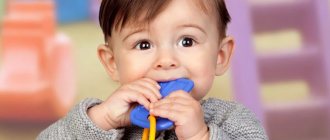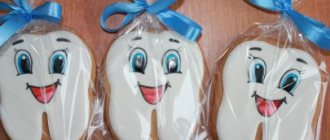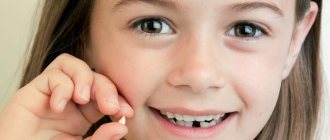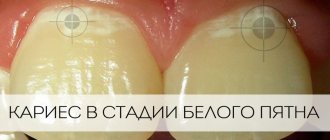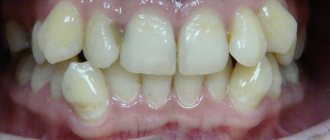Signs about who saw the baby's first tooth
There are a number of interpretations for those who noticed the child’s first tooth. The sign is considered a good sign and promises good news. The people treated the event with great trepidation. It predicted the future for the family:
- The appearance of a tooth is usually noticed by the mother. If it comes out earlier than four months after birth, the event promises her an early pregnancy.
- If the child’s father turns out to be more observant, the sign means profit and financial well-being for the family.
- A grandmother who notices her grandson's first tooth will live a long time. For grandfather, the event foreshadows a meeting with an old friend.
- If the godmother saw the first milk tooth, signs for an unmarried girl predict a quick wedding. If she is married, offspring are expected in the family soon.
- The event promises wealth and good luck to the godfather. This is a good sign for the child: fate will be favorable to him.
- It happened that older children noticed teething. An observant boy was predicted to have a successful career, a girl - early marriage.
After the appearance of the first tooth, fortune telling was performed
Symbolic objects were laid out in front of the baby - a hammer, a ladle, scissors, a stethoscope. What a child is drawn to will determine his future profession: carpenter, cook, fashion designer or doctor.
Attention! If your first tooth appears on Monday, you shouldn’t plan a trip. Notice on Sunday - your cherished dream will come true in the near future.
Individual characteristics of the appearance of teeth
It is worth noting that there is no single answer to the question of what time a baby’s first teeth begin to cut, since the development of a child as a whole is of a purely individual nature. But, on average, the appearance of teeth can be expected in the range of four to nine months.
This process is influenced by many factors. Among which:
- genetic predisposition and heredity for the appearance of teeth in a child
- living conditions of the baby - climate, nutrition
- compliance with the regime during the mother's pregnancy.
The gender of the child also influences. Doctors have noted that the appearance of the first teeth in girls occurs much earlier than in boys, which characterizes the general trends in the development of children.
Girls under one year of age develop more rapidly, begin to walk earlier and, sometimes, by this age they utter their first words.
A sign if the first tooth comes out from above
The first tooth is associated with many folk signs and customs. When deciphering an event, pay attention to the accompanying details:
- If a second appears immediately after the first, and there is a gap between them, the sign promises the child good luck in life. He will achieve great success, higher powers favor him.
- They also wondered about the child’s character. If the tooth erupts for a long time, painfully, the baby will be thoughtful, prone to melancholy, rapid eruption - a real fidget will grow up, which will cause a lot of trouble for parents.
- If a child’s first tooth comes out from above, a new addition to the family is expected soon; the signs promise parents news of pregnancy within a year.
- During teething, you cannot leave the baby, it is believed that during this period evil spirits may attach to it.
- The eruption of the lower one foreshadows the manifestation of talent. The heir can become a famous person who glorified his family.
- If the first upper tooth came out immediately after birth or the baby was born with incisors, the signs endowed the child with a special destiny. The people believed that this was a sign of the ruler.
To facilitate teething, the first baby tooth that falls out should be thrown over the shoulder at the intersection
Possible reasons for the delay
The absence of baby teeth by the age of one year alarms parents and pediatricians. The reasons for delays in the formation of the masticatory apparatus are the following factors:
- Calcium deficiency. At one year of age, children with rickets have no milk teeth. Calcium may not be absorbed due to disruptions in the gastrointestinal tract and metabolic disorders.
- Heredity. If one or both parents developed incisors late, their children will inherit the same feature. There is no way to speed up the natural process.
- Edentia. There are no tooth primordia in the jaw. Adentia can be complete or partial. You can see how many tooth germs there are in the jaw using an x-ray. The procedure is prescribed by a dentist.
- Hormonal disorders. Malfunctions of the thyroid gland shift the timing of a baby’s development.
- Infectious diseases at an early age. Past illnesses affect the body’s supply of necessary vitamins and minerals and disrupt the rhythm of development.
- Prematurity. In children born prematurely, all physiological processes are often delayed by one to two months.
What do you give to a child for his first tooth?
Teething had a symbolic meaning. This is a significant event after birth. It was believed that after the appearance of the first incisor, the baby could be shown to strangers. Before this, only relatives and godparents were allowed to look at the child. This is how the baby was protected from the evil eye and damage. It was believed that if the teeth were large and wide, the child would be kind and generous, while small, narrow teeth predicted a quarrelsome character.
If the first baby tooth has been lost, the child will live away from home
What does the godmother give for the first tooth?
According to customs, the godmother gives a silver spoon for the first tooth. The metal is considered precious and symbolizes wealth and prosperity. The gift promised the baby good and prosperity in the future. Silver was associated with the protection of the Moon, protection from troubles and misfortunes. They put a spoon in the baby's crib. She served as a talisman and protected the baby's sleep. The godmother is considered the child’s mother before higher powers and is responsible for his spiritual development. The donated spoon also symbolizes the spiritual food necessary for the development of goodness and piety.
The appearance of the first tooth meant the need to introduce complementary foods. Silver has unique antibacterial properties. Bacteria die on its surface, and the metal disinfects food and water. Silver ions help not only fight toxins, but also strengthen the immune system, protecting the baby from colds.
Advice! Before giving a spoon, you need to immerse it in blessed water for 3 days.
This way she will absorb holy energy and protect the child from illness.
It is recommended to choose products without protruding edges that are safe for babies
What do grandparents give for the first tooth?
Grandparents are the oldest representatives, the roots of the family. Not only their gifts are important, but also their wishes. The energy of love and care will help the baby grow healthy and happy, to the delight of all relatives. Grandparents can give a small family member a bag of silver coins. A symbolic gift is a wish for a long, rich life, not only materially, but also spiritually. It was believed that silver absorbed evil spirits; darkening of the metal meant damage, the evil eye. It is enough to clean the product of plaque to restore its magical properties.
What do you give a boy for his first tooth?
In addition to the spoon, you can choose other gifts made of silver. The first tooth symbolizes the beginning of the transition from mother’s care to the big world. Symbolic gifts are recommended to protect the child’s energy:
- You can give a set of silver so that the boy grows up strong and healthy.
- The icon with the savior will protect the child and will become a valuable gift for the whole family.
- The silver chain symbolizes the endless circle of life, the youngest child becomes a continuation of the family.
What do you give to a girl for her first tooth?
A girl should also be given gifts made of silver. They will help maintain the purity of the soul and protect from bad thoughts. A gift for the first tooth is presented with parting words for future growing up:
- The silver-plated icon of the Mother of God is a powerful protection for the girl and will help her become the guardian of the hearth.
- The silver ring given for the first tooth was kept for the engagement. It was considered the key to a happy family life.
- A silver cup will help you grow beautiful not only in face, but also in soul. Drinking water cleanses you of bad thoughts, envy, and fills you with love and goodness.
Gift for the first tooth
Traditionally, it is believed that godparents give an expensive gift to a baby. This can also be done by the person who discovered the first tooth in the baby’s mouth. This event should not be ignored. Otherwise, the baby will be doomed to illness.
Gifts for your baby may include toys or hygiene items. But the best gift option is a silver spoon. From the moment the first teeth erupt, the baby is given not only milk, but also supplementary food. Silver has the ability to disinfect water and food, so parents can rest assured that dangerous bacteria will not get into their child’s mouth.
Be sure to tap the tooth with the given spoon. These actions symbolize that the baby will be able to eat the same food as his parents and at the same time all his teeth will remain healthy until they fall out.
Due to its purifying properties, silver is used in the production of crosses. It is from this material that crosses are acquired immediately after baptism.
Why do people give a silver spoon for their first tooth?
The custom of giving a silver spoon appeared a long time ago. Such a gift meant the wealth of the family, which means that the baby had a predictable happy future. The sign is associated with the first complementary foods; silver has antibacterial properties, prevents infections of the oral cavity and colds. The gift is considered a wish for good health and prosperity, and promises a happy, carefree life for the baby.
To protect the baby from dark forces, the name of the Guardian Angel is engraved on the donated product.
The custom also has another meaning: the silver spoon also symbolized the spiritual path. The gift should remind the growing child to maintain pure thoughts.
Symptoms
Teething in babies is a natural process. This age period is perceived by mothers as the most difficult. The small organism malfunctions, the baby experiences constant discomfort.
It is easy to recognize that a baby is cutting its first teeth by the following accompanying signs:
- Increased salivation. It begins 1–2 months before the appearance of the incisors.
- The desire to scratch the gums, chew something. The baby puts fingers, toys, and diapers into his mouth. He chews everything he can get his hands on with pleasure and calms down. This sign is common to all children.
- Increased nervousness, moodiness. The baby cries, tugs, and feels his gums.
- Sleep disorders. Babies 3–6 months old wake up at night, rock hard, and won’t let the bottle or breast out of their mouth. In rare cases, newborn toddlers may cry all night and day long. Don’t worry, the child is in severe pain, the tooth will appear soon.
- Lack of appetite, complete refusal to eat. It is observed at the stage of active tooth eruption. Hunger strike or weak appetite lasts 2-3 days.
- The lymph node behind the ears is inflamed. The bump does not pose a threat to the baby. To rule out the disease, get tested, check the level of leukocytes and lymphocytes.
- Swelling, swelling of the gums. Redness and swelling are observed at the site of the future tooth. The remaining parts of the gums are calm.
- Increase in body temperature during teething. Hyperthermia manifests itself in different ways. In some infants, the temperature rises by 1–1.5 degrees, in others it goes off scale – up to 39–40°C, lasting from one to three days. Important! If your baby has a high temperature for four or more days, the gums are completely swollen, there is diarrhea, or skin irritation, consult a doctor. Perhaps the cause of the discomfort was not the teeth, but an infection.
- Runny nose, mild wet cough. These signs of teething are triggered by copious amounts of saliva. They have nothing to do with colds.
- Diarrhea. Weak loose stools are observed for one to two days. Your stomach may hurt.
- Irritation on the skin of the face and chest. Red spots and itching of the epidermis are provoked by children's saliva, which gets on the chin, cheeks, and neck.
This is interesting! Increased salivation saves the baby from some discomfort during teething. Saliva has an antibacterial and analgesic effect. If the incisors appeared unaccompanied by a large amount of moisture in the mouth, then the kids would experience much more discomfort.
Who gives a spoon for the first tooth?
As a rule, whoever saw it first presented a symbolic gift. Babies were protected from prying eyes, so only close people - parents, godparents, relatives - could notice the teething. The tradition of giving a silver spoon for the first tooth is still relevant today. The boy is usually given a gift by his godfather, or his grandfather or father can also give him a gift. With a precious gift, a man conveys his wish to grow strong and courageous.
The godfather should knock three times with a spoon on the erupting tooth, according to legend, the next incisors will come out easily and painlessly
Who gives a spoon to a girl's first tooth?
Traditionally, the little princess is given a gift by her godmother or the eldest in the family - grandmother, great-grandmother. The silver spoon was given with wishes of health for the baby and joy for her parents. If the gift was given by an unmarried godmother, it means that she will have a girl first. For a married woman, the omen promised the birth of a boy. For a grandmother who gave a valuable gift to her granddaughter, the belief foreshadowed long years of life.
Teething order
Baby teeth should emerge in a pattern determined by nature. The timing varies greatly.
We present the average age indicator for the formation of the masticatory apparatus, which is accepted by pediatricians. The normal sequence should look like this:
- Central incisors - 4 teeth. First, the 2 lower ones come out - from the 6th to the 10th month, then the 2 upper ones - from the 7th to the 12th month.
- Lateral incisors - 4 teeth. By the 9th–12th month, 2 upper incisors appear, by the 7th–16th month, 2 lower ones.
- Fangs - 4 teeth. They usually grow almost simultaneously from the 16th to the 23rd month.
- The first molars are 4 teeth. The bottom erupts from the 12th to the 18th month, the top - from the 13th to the 19th month.
- Second molars - 4 teeth. Last milk teeth. The lower ones appear at the end of the baby’s second year of life - up to the 31st month, the upper ones - from the 25th to the 31st month.
To track how children's teeth grow according to the schedule, use the picture. Print out the calendar and hang it in a visible place, noting the incisors that have already appeared.
Print the calendar in large format (click on the image to enlarge) and fill it out with your child:
Use of Medicines
Modern pharmacies sell a lot of products to help babies teething. These are gels, ointments, sprays, drops. They have an anti-inflammatory, analgesic effect, relieve itching and burning. With their help, the period of teething is easier for children, but it will not be possible to completely relieve pain and anxiety.
The following tools are popular among parents and pediatricians (Important! The table can be scrolled left and right on mobile devices):
| A drug | Properties | How to use | Contraindications |
| Gel "Cholisal" | Relieves inflammation, redness, and soothes gum pain. | Apply 2-3 times a day | • Age up to one year. • Intolerance to choline salicylate, cetalkonium chloride. • Breast-feeding. |
| Gel "Kamistad Baby" | Fights germs, relieves pain, relieves redness in the mouth, swelling, heals wounds. | Apply to inflamed gums 3 times a day, no more than 5 mm per application. | • Age up to 3 months. • GV. • Individual intolerance to lidocaine. • Diseases of the kidneys, liver, heart. • Increased blood pressure. |
| Drops, gel "Dentinox" | Pain reliever. | Apply to gums 3 times a day. | Allergies |
| Homeopathic gel “Baby Doctor. First teeth" | Anti-inflammatory, analgesic. | Apply to sore gums and inner cheeks every day as needed. | Individual intolerance |
| "Kalgel" | It has antifungal, analgesic, and antiseptic effects. | Apply up to 6 times a day. After the last application, you need to wait 20-30 minutes, then you can use it again. | • Kidney, heart, liver failure. • High blood pressure. • Individual intolerance. |
| Drops "Dantinorm Baby" | Anesthetizes gums, disinfects the oral cavity, reduces inflammation. | Take 1 ml of the drug between meals no more than 3 times a day. | • Age up to 3 months. • Individual intolerance. |
| Gel, cream "Solcoseryl" | Heals wounds, relieves inflammation. | Apply 1-2 times a day to affected areas of the mouth. | • Tendency to allergies. • Individual intolerance. |
Important! Homeopathic remedies are considered to be effective, safe, inexpensive medicines for young children. But do not forget that they are made from natural herbs, plant extracts, and oils. It is dangerous to use them for babies prone to allergies.
In addition to discomfort in the mouth, itching, the child may be bothered by high fever and headache. In this case, use antipyretics:
- "Panadol"
- Paracetamol for children
- Ibuprofen
- "Viferon"
- "Nurofen"
For infants up to one year old, buy suspensions and suppositories; older children can be given a tablet by dissolving it in water. These remedies combine several properties: they lower the temperature, relieve headaches, and pain in the mouth. The effect lasts for at least 6–8 hours. Calculate the dosage according to the instructions for the drug, taking into account the age and weight of the baby.
Scheme of eruption of permanent teeth
Children acquire a full permanent set of teeth by the age of 12–15 years. Teeth begin to renew in older preschool age, at 5–6 years. But first, “sixes” will come out in the place where there were no milk teeth. These are called first molars and will be replaced by premolars after age 10. “Sixes” fill the gap in the jaw before the first baby teeth fall out.
The remaining baby teeth will emerge in the following sequence, shown in the table:
| № | What teeth are coming through? | Child's age, years |
| 1. | Central lower incisors | 6–7 |
| 2. | Central upper incisors | 7–8 |
| 3. | Bottom twos | 7–8 |
| 4. | Upper lateral incisors | 8–9 |
| 5. | Lower canines | 9–10 |
| 6. | Upper canines | 11–12 |
| 7. | First upper premolars | 10–11 |
| 8. | First lower premolars | 10–12 |
| 9. | Upper second premolars | 10–12 |
| 10. | Second lower premolars | 11–12 |
| 11. | Second lower molars | 11–13 |
| 12. | Upper second molars | 12–13 |
| 13. | Third upper and lower molars | 17 and older |
A graphic diagram will help you understand the order of formation of a permanent bite:
Common Misconceptions
Superstitions, misconceptions and stupid recommendations from “experienced” grandmothers accompany the childhood of any child. Among them we can highlight the most popular ones.
- All children's teeth should grow at the same time and in the same order. Condemning the baby for late teething and minor deviations in the sequence cause mothers a lot of trouble. There is no need to compare children. If your neighbors Vovka and Mashenka have two teeth at six months, and your Dima still has none, this does not indicate developmental pathologies. Every child is unique from birth.
- When teething, a high temperature necessarily rises. It is important to understand why this happens. Hyperthermia occurs due to inflammation of the gums and infection of the baby. If the child’s immunity copes with the bacteria, the temperature will not rise.
- Babies should not suck on pacifiers or bottles while their baby teeth are emerging. Supposedly this will ruin the bite. This statement is wrong. The pacifier does not affect the permanent bite if by the age of 6–7 years the child has weaned himself from sucking a finger and a pacifier.
- There is no need to clean or treat baby teeth. When babies eat adult food, and not just mother’s milk or formula, it’s time to start brushing their teeth and still toothless gums. Teach your child to good hygiene so that he does not have bad breath or caries, which transfers to permanent teeth from milk teeth.
- You can get rid of swelling on the gums and runny nose with antihistamines. This is true if the snot and swelling in the mouth are caused by allergens. During teething, these symptoms have a different cause. The baby cannot be treated with antiallergic medications.
How to help your baby
When the baby is restless, cries, sleeps poorly and hardly eats because of pain, mothers are ready to make any sacrifice so that the child gets rid of discomfort. Infants are provided with special care, parents try to console the baby with games, persuasion, and affection. But this is not always effective.
There are a number of recommendations to help cope with pain and moodiness:
- Special teethers. Buy “rodents” of various shapes at the pharmacy. They are made of silicone and rubber. Sometimes filled with water to keep them cool. The child massages the gums, the pain subsides.
- Pacifiers, bottles, pacifiers. The baby uses them as teethers and a means of relieving itching in the mouth. Make sure that the integrity of the pacifier is not compromised. An infant may choke on a piece of latex.
- Gum massage. Gently, without pressing the cheek, stroke the swollen areas with your fingers. Before the procedure, wash your hands and wrap them in a bandage, soak them in chamomile decoction.
- Finger brushes. Used to clean babies' first teeth. During the period when the incisors appear in front, they can be used as a means of massaging the gums.
- Liquid food. Solid food can cause discomfort when chewing for a toddler. Replace main courses with soups and vegetable purees.
